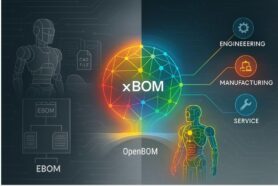
Customer experience is one of the most fundamental things I wanted to focus on when I started OpenBOM. Working with engineers for many years while selling PLM products taught me that only a deep understanding of how engineers work can help to develop a product that helps manufacturing companies. And engineers are a very unique bunch of people.
For the last few years, I learned that developing unique and dynamic relationships between customers, prospects and software developers is extremely important and it goes much beyond a transactional exchange between software vendors providing a product and manufacturing companies buying software.
This key to this successful relationship is characterized by a mutual learning process—a continuous cycle of knowledge transfer and refinement that benefits both parties involved. It’s a synergy where customers and vendors collaborate, share insights, and evolve together in pursuit of common goals. In other words, our customers and prospects learn from us and on the other side, we learn from customers about how they work and what they need.
In the world of SaaS software where the product is actually a service that is in a perpetual development process, it creates a completely different and unique experience. An example is what I wrote in my article earlier this week – My Top 10 New Features from 2023. OpenBOM made 11 production upgrades (not counting different fixes) and many of these features were born in close communication and collaboration with our customers and prospects.
In this article, I’d like to share my top 5 things I learned in 2023 and how I think it can help future OpenBOM customers adopt technologies to drive innovation, improve products and services, and ultimately lead to the success of both parties.
1. Manufacturing is complex, Therefore Simplicity Wins
One of the most significant takeaways from our interactions with engineers is that simplicity is crucial. Engineers have demanding schedules and complex tasks to tackle. They need software tools that are easy to use and don’t require an extensive learning curve. The lesson here is clear: prioritize simplicity in product design and user experience. Make it easy for engineers to integrate your solution into their workflow, and you’ll earn their loyalty. However, don’t make a mistake – simple, but not simpler. You cannot simplify it to the level it will become useless. It is a hard balancing act in engineering and manufacturing software.
2. Education is Extremely Important, Even If You Think Something is Obvious
In our conversations with customers and prospects, we’ve realized that what may seem obvious to us may not be so for others. A typical engineering approach is to think about solutions and pass the stage of “problem”. Which very often creates the situation when prospects and customers are “looking for a solution”. We found that spending time on education, and understanding the problem can help to find a better solution. At OpenBOM, we are providing comprehensive educational resources, tutorials, and documentation resources to help our prospects and customers. Users appreciate when a company takes the time to explain how to maximize the benefits of their product. Although, everyone will tell you that nobody reads documentation these days (which is true, btw :)), but we recommend never underestimating the power of good documentation and training materials—they can make or break a user’s experience. At OpenBOM, the training library is a key. In 2023, we completely changed “what’s new section” to reflect the experience we had and what we learned.
3. Focus on a Process to Connect with Users
Connecting with users isn’t just about providing customer support; it’s about building relationships. A systematic approach to engaging with customers and prospects is essential. Whether it’s through regular email newsletters, webinars, or user community forums, maintaining an ongoing dialogue with your audience fosters trust and loyalty. Listen to the feedback, address concerns, and continuously improve your product based on customers’ input. In 2023, we introduced the OpenBOM community, continued weekly newsletters, and introduced a new service – Live Demo Sessions, which we plan to continue in 2024.
4. Old Paradigms are Sticky, and You Need to Connect to Them
In the world of technology, change is constant, but old habits die hard. It is always amazing how sticky are existing paradigms in the heads of engineers and everyone else in the manufacturing business. Many industries and professionals hold on to traditional methods and processes. You cannot change it overnight. When introducing innovative new solutions like OpenBOM, it’s crucial to bridge the gap between the old and the new. Show users how your product can seamlessly integrate with their existing workflows and provide solutions to their pain points. Recognize that change can be daunting and offer support in their transition. Import and export (as seamless as possible) was one of the most critical elements of OpenBOM adoption. OpenBOM one-click BOM integrations, Workspace Manager Smart Sync, and others are examples of how tight integration between existing data management paradigms helped our customers to understand and leverage new tech and tools.
5. Decisions Are Emotional—Give People What They Like
While it is absolutely important to make deep analysis and make data-driven decisions, emotions play a significant role in the choices of engineers to use one or another product. People prefer working with tools they enjoy using. Investing in the aesthetics and user experience of your product can make a substantial difference in user adoption and satisfaction. For OpenBOM, visual experience was a key element. So called “BOM with images” was a killer function for many users who liked OpenBOM in the first place. You can import images from spreadsheets , automatically create images from CAD systems using Add-ins, and capture images automatically when synching files – these are just a few examples. Visual dashboard and graph navigation is another great example of helping to make emotional decisions. Ensure that your product not only performs well but also appeals to users on an emotional level.
Conclusion
At OpenBOM we learned a lot from our prospects and customers. Those are key elements of our product vision – to combine our strategy with experience and things we learn from our customers. We believe this is the best way for us to build a successful service. More than 450 reviews on G2 and customer stories are a confirmation of what we do.
In 2023, OpenBOM has gained valuable insights from our customers and prospects that have helped us refine our approach to product development and customer engagement. Engineers crave simplicity, education is invaluable, relationships require effort, old paradigms persist, and emotions influence decisions. By keeping these lessons in mind, we aim to continue providing innovative and user-centric solutions to empower engineers and manufacturers in their daily endeavors. Remember, in the ever-evolving landscape of technology, understanding and adapting to your users’ needs is the key to success.
REGISTER FOR FREE and check how OpenBOM can help you. Contact our support with questions.
Best, Oleg
Join our newsletter to receive a weekly portion of news, articles, and tips about OpenBOM and our community.










